The Nieuwe Kerk (New Church) and the Oude Kerk (Old Church) of Delft were originally built as Catholic churches. The former was dedicated to the Virgin Mary and Saint Ursula, while the latter was dedicated to Saint Bartholomew and Saint Hippolytus. All this was changed by the Reformation, the sixteenth-century reform movement in Christianity. Calvinism, named after the Swiss reformer John Calvin, became the most important Protestant denomination in the Northern Netherlands. Calvin's followers did not accept the teachings of the Catholic church as the guideline for their lives, but lived by the words of the Bible. The resulting religious strife was a major factor in the Eighty Years War.
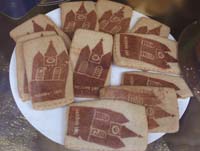 Cookies in a Delft bakery are decorated with the tower of the Oude Kerk.
Cookies in a Delft bakery are decorated with the tower of the Oude Kerk.At the conclusion of this war the Reformed Church became the national church of the Dutch Republic. All churches, including the SS. Bartholomew & Hippolytus (Oude Kerk) and the SS. Mary & Ursula (Nieuwe Kerk), became the property of the Reformed Church. Catholics did enjoy religious liberties, but were not allowed to express their faith in public, which is why they built clandestine churches.
Whole families were split by the Reformation. Part of the prominent patrician Van der Dussen family, for example, remained true to the teachings of the Catholic Church, while the majority of those who aimed for public office converted to the Reformed Church.
Oude Kerk
The Oude Kerk, the oldest parish church and oldest building in Delft, was officially founded in 1246 (the same year in which Delft received city rights by count William II) even though it is generally assumed that there had been a wooden church on this site as early as 1050.
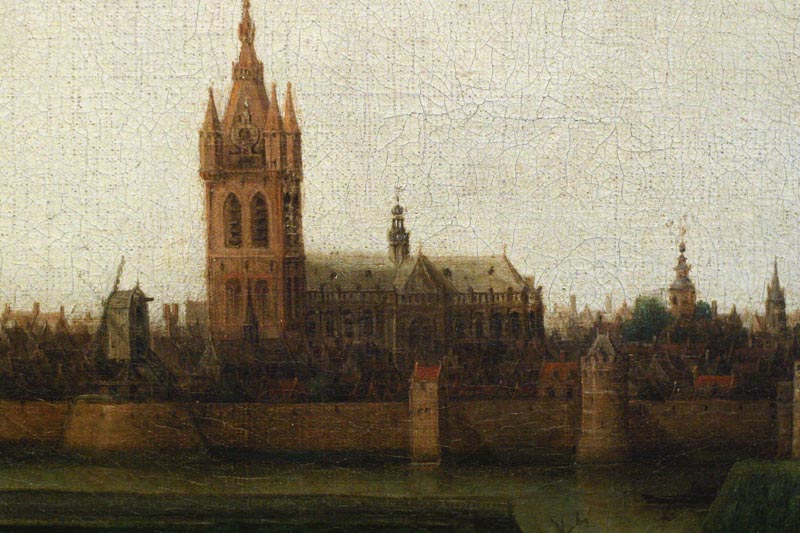
Hendrick Vroom
1615
Oil on canvas, 71 x 160 cm.
Museum Het Prinsenhof, Delft
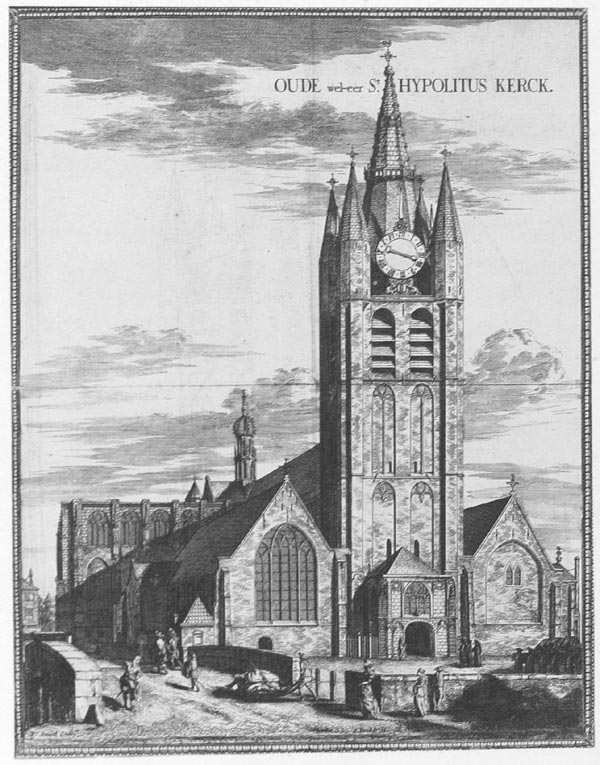
Coenrad Decker
1667
Engraving, 330 x 267 mm.
Private collection
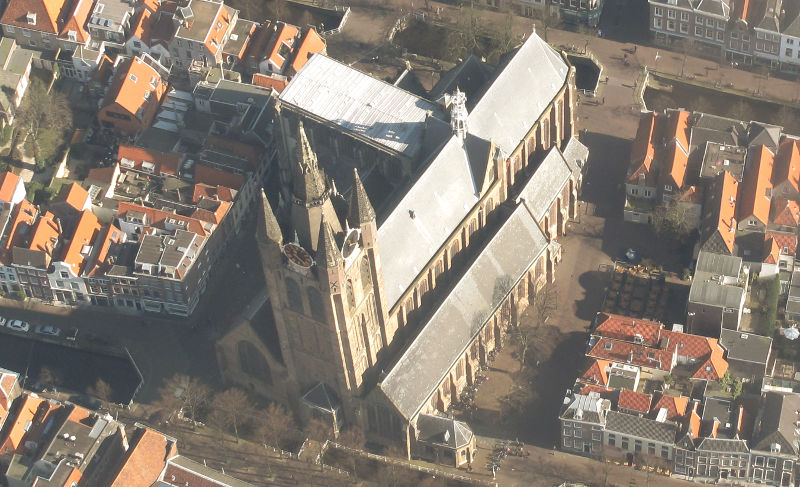
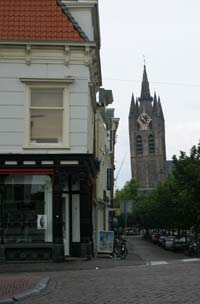
This church was originally known as Saint Hippolytus-church. In the middle of the thirteenth century, the earlier building had been rebuilt and extended by Bartholomew van der Marde. The church bore the name of the patron saint, then called Saint Bartholomew Church. The gothic tower, with its brick spire and four angle towers, was added between 1325 and 1350. The precious interior including the elaborately crafted stained-glass windows had been completely destroyed by the iconoclasts of 1566 and 1572. Only the beautifully carved pulpit from 1548 has survived. Throughout the ages, the leaning tower, probably built on an early filled-up canal, has been the cause of considerable alarm to many inhabitants. In 1843, the City Council of Delft, fearing the collapse of the tower, decided that it had to be pulled down to the level of the church roof. Local contractors were able to prevent this decision from actually being carried out. Nowadays, the leaning tower of Oude Kerk is a prominent emblem of Delft, fondly called by the citizens the "Scheve Jan," which translates to "Leaning Jan"
On 15th December 1675, Vermeer was buried in Oude Kerk, in a family crypt in the northern transept, bought by his mother-in-law Maria Thins in 1661. But when he died there was no money for a tombstone. Today his burial place has two grave markers (fig. 1 & 2) : a rather austere one from 1975 to commemorate the 300th anniversary of his death, located at about the same place as the former family grave, and a new larger, discreetly decorated one near the western side entrance placed 26th January 2007. However, while we no longer know the exact location of Vermeer's tomb in the Oude Kerk, the great Delft artist is in the company of some of the city's most excellent citizens.
Approximately 400 people are entombed in the Oude Kerk, including: Elizabeth Morgan, daughter of nobleman Marnix van St. Aldegonde (1608; noblewoman and benefactrix Clara van Spaerwoude; naval hero Piet Hein (1629); writer Jan Stalpaert van der Wiele (1630); naval hero Maarten Tromp (1653) physician-anatomist Regnier de Graaf (1673); painter Hendrick Cornelisz van Vliet, who had painted the church interior (1675); statesman Anthonie Heinsius (1720); scientist Anton van Leeuwenhoek (1723) and poet Hubert Poot (1733); and of course, Vermeer.
Vermeer's final resting place was in a designated "Own Grave" (Eijgen Graff) within the Oude Kerk. As for the burial registry, this took place on 16 December 1675. The grave plot was under the ownership of his mother-in-law, Maria Thins. Notably, several of Johannes and Catharina's children had been laid to rest in the same burial plot before Vermeer's own passing.
Recently, Archivist Bas van der Wulp made a groundbreaking discovery: a reference to Vermeer in a burial registry of the Oude Kerk. This reference had been overlooked for years, as no one had previously searched for a record of Vermeer’s funeral in this particular register. The records highlight that during Vermeer’s funeral on December 16, 1675, his coffin was escorted by an impressive fourteen pallbearers, with bells tolling solemnly. Van der Wulp notes, "Such a grandiose send-off was undoubtedly luxurious. There were funerals with as many as twenty pallbearers, reserved for the crème de la crème. Vermeer’s affluent mother-in-law, Maria Thins, had an even more elaborate funeral with bells ringing in two intervals. However, Vermeer's funeral was far from ordinary"
What's particularly striking is that Vermeer had no wealth at his demise, coming three years post the calamitous year of 1672. Van der Wulp speculates that the artists' guild, which Vermeer once presided over, likely didn't foot the bill given that fellow guild artists weren't afforded such grand funerals."Johannes Vermeer was given a funeral with 14 pallbearers and bells ringing, according to an archive find." Pledge Times, by admin_l6ma5gus. World Europe, January 18, 2023. Accessed October 31, 2023. Intriguingly, Maria Thins' son and Vermeer's brother-in-law, Willem Bolnes, who was institutionalized due to mental health issues, received a similar funeral a year later. Van der Wulp surmises, "Maria Thins likely bore the funeral expenses. She might have perceived it as advancing the funeral costs to her daughter, possibly unaware of Vermeer's dire financial straits."
In the early days, Maria Thins, a devout Catholic, was initially against the union between Vermeer and her daughter, Catherina Bolnes. This could be attributed to Vermeer being of Reformed heritage and his humble beginnings as an innkeeper's son. "However," Van der Wulp shares, "following an intervention by two of Vermeer’s close friends, Thins relented. A legal document confirms her decision not to sign the ‘deed of consent’, but to lift her objections." The couple subsequently wed in a Catholic ceremony in Schipluiden and named all their offspring with Catholic monikers. Van der Wulp adds, "Though it's speculative, Maria Thins likely had a say in that decision."

An austere plaque in the northern transept opposite the pulpit marks the grave of Johannes Vermeer. Recently, the city of Delft added a new, more elaborate tombstone.
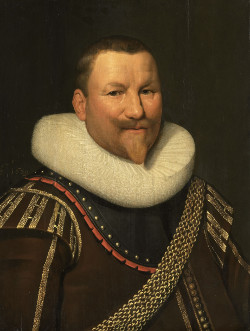
After Jan Daemen Cool by an unknown painter
c. 1589–1660
Piet Hein
Piet Hein, Heyn, original name Pieter Pieterszoon (fig. 3), (1577–1629), admiral and director of the VOC (Dutch West India Company) who captured a Spanish treasure fleet (1628) with 4,000,000 ducats of gold and silver (12,000,000 gulden, or florins). That great naval and economic victory provided the Dutch Republic with money to continue its struggle against Spain for control of the southern, or Spanish, Netherlands (now Belgium and Luxembourg). Hein's elegant mausoleum in the Oude Kerk features a marble statue. The plinth and statue were sculpted from a single block of marble. This sculpture rests on a pedestal of black marble.
After being captured at sea in 1597, Heyn spent four years as a Spanish galley rower. After being released in an exchange of Dutch and Spanish prisoners (1602), he became a merchant skipper and amassed a sizable fortune. In 1621, he became a director of the Dutch West India Company, formed to promote and protect the Dutch contraband trade with Spanish and Portuguese colonies.
Three years after his 1624 appointment as a vice admiral of the fleet, Hein captured 22 Portuguese ships at San Salvador, Brazil. In September 1628, at Matanzas Bay, Cuba, he captured part of a fleet that was carrying an annual shipment of precious metals mined in Mexico and Peru to Spain. He had planned to retire with his share of the booty but was recalled to active duty with the rank of lieutenant admiral of Holland in 1629. He was then given command of the republic’s entire fleet and ordered to clear the North Sea of the Dunkirk pirates, who were in the pay of King Philip IV of Spain. Although his fleet destroyed the pirates (June 1629), Heyn was killed in the battle.
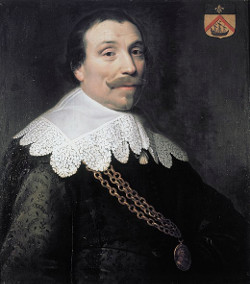
Michiel van Mierevelt
1640
Oil on panel, 62.5 × 55.5 cm. Private collection
Maarten Tromp
An elaborate and elegant mausoleum was erected at the northern side of the church in remembrance of Maarten Harpertszoon Tromp (fig.3,
the highly decorated Dutch admiral who heroically died in battle. During the Dutch struggle for independence from Spain in 1639, Tromp defeated a large Spanish fleet bound for Flanders at the Battle of the Downs, marking the end of Spanish naval power. In a preliminary battle, the Action of 18 September, 1639. Tromp became the first fleet commander known to deliberately use line of battle tactics. His flagship in this period was the Aemilia. The death of Tromp was not only a severe blow to the Dutch navy, but also to the Orangists who sought the defeat of the Commonwealth of England and restoration of the Stuart monarchy.
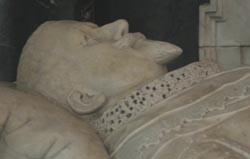
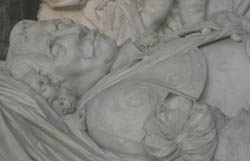
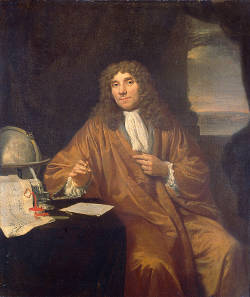
Jan Verkolje (I)
Oil on canvas, 56 x 47.5 cm.
Rijksmuseum, Amsterdam
Anthony van Leeuwenhoek
Van Leeuwenhoek (fig. 4) was a Dutch businessman and scientist in the Golden Age of Dutch science and technology. A largely self-taught man in science, he is commonly known as "the Father of Microbiology," and one of the first microscopists and microbiologists. Van Leeuwenhoek is best known for his pioneering work in microscopy and for his contributions toward the establishment of microbiology as a scientific discipline. Van Leeuwenhoek was a contemporary of another famous Delft citizen, Vermeer, who was baptized just four days earlier. It has been suggested that he is the man portrayed in two Vermeer paintings of the late 1660s, The Astronomer and The Geographer, but others argue that there appears to be little physical similarity. Because they were both relatively important men in a city with only 24,000 inhabitants, it is likely that they were at least acquaintances; van Leeuwenhoek acted as the executor of Vermeer's will after the painter died in 1675.
Nieuwe Kerk
According to Dirk van Bleiswijk's Beschrijvinge der Stadt Delft'Description of the town of Delft', 1667), the Nieuwe Kerk had its origins in 1351 with the repeated visions of a somewhat eccentric beggar. He described his visions of a golden church bathed in bright light at a specific spot on the market square to a person who occasionally brought him food.
After the beggar's death, this individual experienced the same vision for thirty years on the exact same day each year. Two devout Beguines—one of them with the stigmata of Jesus Christ, as Van Bleyswijck tells, certainly Geertruit van Oosten—supported the request of the fellow that a church had to be built at that place. The building of a basilica finally started in 1396. It was built around a wooden church that remained until 1420. Exactly 100 years later, in 1496, the tower was finally ready. The church was dedicated to the Virgin Mary (the patron from the former wooden church) and to Saint Ursula.
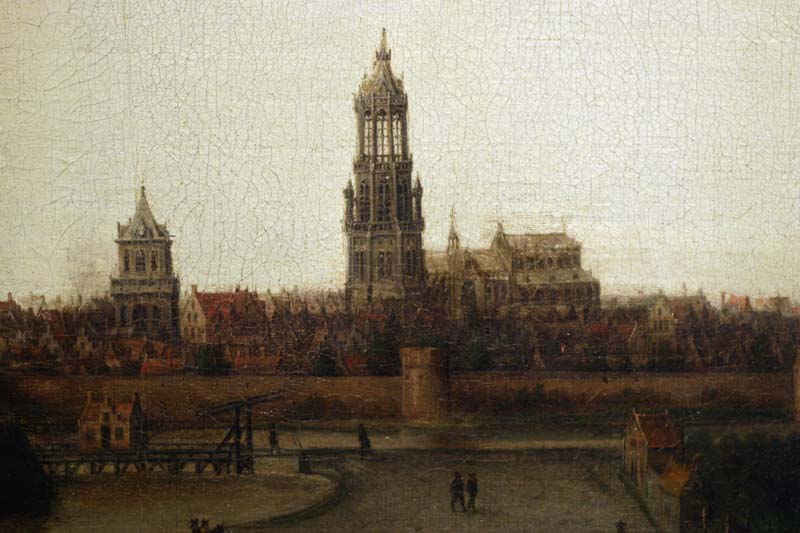
Hendrick Vroom
1615
Oil on canvas, 71 x 160 cm.
Museum Het Prinsenhof, Delft
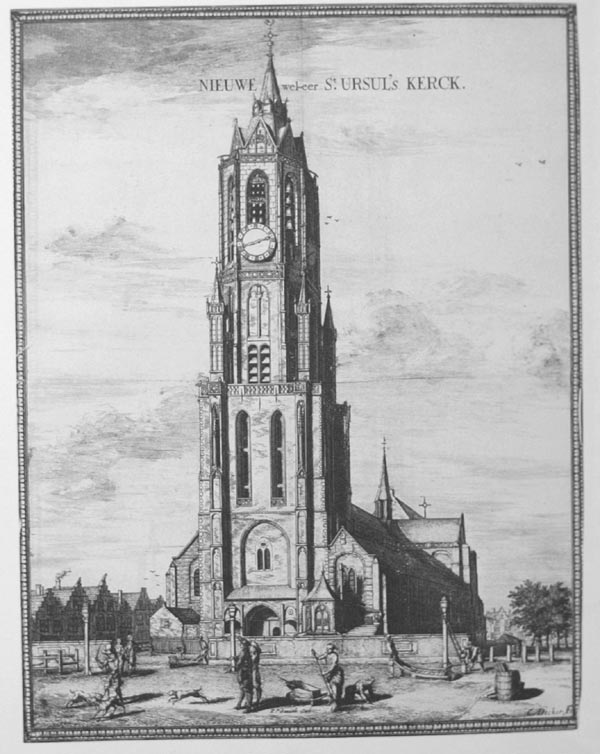
Coenrad Decker
1667
Engraving, 330 x 267 mm.
Private collection
The tower was struck on 3rd May 1536 by a heavy lightning which, fanned by a strong wind, led to the subsequent fire which devastated a great part of Delft. The iconoclasts of 1566 left their horrible marks as well. In 1572 the building was taken over by the Reformed Church. The Delft powder magazine explosion on 12th October 1654 destroyed the roof and the new made stained-glass windows, but the church could already be used again by spring 1655. In 1872 another heavy lightning destroyed the tower once more. It was rebuilt in 1875 (designed by Petrus J. H. Cuypers who in 1885 also designed the present building of the Rijksmuseum Amsterdam) to its present height of nearly 109 meters, only surpassed in the Netherlands by the Dom tower in Utrecht.
Since the burial of Prince William I of Orange ('the Silent'), father and first stadtholder of the young Dutch Republic, after his assassination in 1584, Breda, where the grave of the Nassau-family was situated, had been in the hands of the Spaniards so that William I had to be buried in Delft. the Nieuwe Kerk remained the final reting place of nearly all members of the house of Orange-Nassau including all Dutch monarchs, and the magnificent monument for William I. (fig. 5), created by Hendrick de Keyser and his son Pieter 1614–1623, is still the object of honor and admiration of thousands of visitors each year, whether Dutch citizens or foreigners, as it has been from the very first moment on, eminent from the numerous paintings with the monument as the principal subject of admiration.
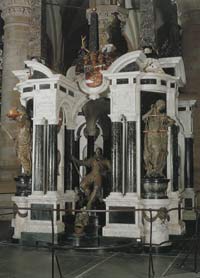
Hendrick de Keyser
It is hard to overstate the importance of Hendrick de Keyser for the Amsterdam architecture of the early decades of the seventeenth century. He single-handedly created what is known today as the Amsterdam Renaissance style through his revolutionary approach to the local Renaissance styles which had developed throughout the Netherlands. The classical vocabulary with which he articulates his architectural designs is carried with even greater emphasis into his sculptural works. He designed the tomb of William the Silent for the Nieuwe Kerk at Delft but did not live to see it finished, his son Pieter completed the project.
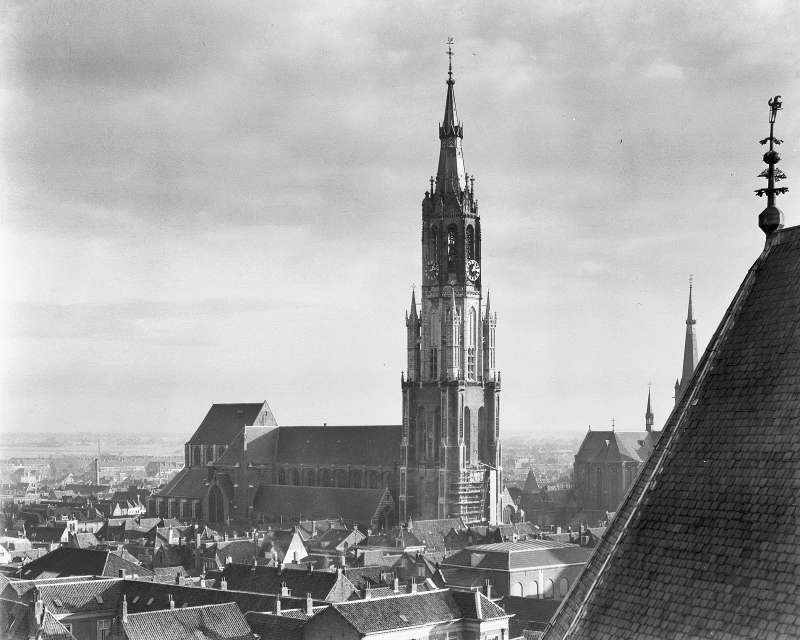
New Directions in Architectural Painting
Around 1650, Delft emerged as the epicenter of innovative architectural painting, marked by a fresh phase initiated by the church interiors painted byGerard Houckgeest (c. 1600–1661) and Hendrick Cornelisz van Vliet (1611 or 1612–1675). Unlike the pioneering architectural painter Pieter Jansz. Saenredam (1597 –1665), who typically positioned his line of vision perpendicular to the church's main axis, Houckgeest introduced a novel perspective by shifting his viewpoint sideways, creating an approximately 45° angle with the church's central axis. This shift resulted in captivatingly complex diagonal vistas across the church interiors. They used techniques like pinholes and chalk cords for accurate perspective and probably made detailed sketches due to the precision of their work. Whileit is unlikely that these paintings were done on-site, the absence of surviving preparatory drawings is considered a significant loss. Around the same time, Emanuel de Witte (1617–1692), also delved into similar perspective experiments. Although he was deeply influenced by Houckgeest, De Witte did not focus on tlle struculral details of the architecture in his interiors. Of greater interest to him was the effect of sunlight, which enabled him to unify his compositions and to strike a balance between the areas o flight and shade. He may well have painted his church interiors without making preparatory studies on paper.

Emmanuael de Witte
1650
Oil on wood, 125.7 x 89 cm.
Hamburger Kunsthalle, Hamburg
This prominent painting of the interior of Delft's Oude Kerk by Gerrit Houckgeest (fig. 6) is notable for being potentially the first depiction of a real church interior in Delft and was highly influential in the genre. The work's exceptional accuracy in representing a particular church view remains unparalleled in seventeenth-century Dutch art. It is believed the painting was commissioned, shifting Gerard Houckgeest's focus from imaginary structures to faithfully capturing real sites.
Instead of the conventional straight-on perspectives that were a hallmark of earlier church interiors, Houckgeest introduced a fresh perspective by employing oblique angles. This not only lent a dynamic feel to his compositions but also offered an intricate diagonal viewpoint of the church space.
His groundbreaking approach didn't go unnoticed. It deeply influenced fellow Delft artists like Emanuel de Witte and Hendrick Cornelisz van Vliet, setting a precedent for architectural precision and intricate detailing in portraying real church interiors. Beyond mere artistic representation, some of Houckgeest's works carried patriotic undertones. Speculations suggest they might have been commissioned by patrons who were staunch supporters of the House of Orange or other Delft dignitaries, emphasizing the sociopolitical weight of his pieces.
Though Gerard Houckgeest might not enjoy the same level of contemporary fame as some of his peers, his pioneering work in the realm of architectural painting—especially his detailed and atmospheric church interiors—cemented his legacy in Dutch Golden Age art.
The piece may have been sponsored by supporters of the House of Orange, including the States General, the City of Delft, the Dutch court, or a private entity. Given the prevailing patriotic sentiments of the time, especially towards the stadholders, and significant events like the burial of Frederick Hendrick and the Treaty of Munster, the artwork might have been created to commemorate these moments. However, the death of Prince Willem II in 1650 likely did not influence this piece.
De Witte was a renowned Dutch artist known for his architectural paintings, particularly of church interiors. Born in Alkmaar, he later moved to Amsterdam, becoming a prominent figure in the city's art scene. De Witte's works are celebrated for their atmospheric portrayal of light and meticulous use of perspective. While he masterfully captured the grandeur of churches, he also highlighted everyday life within these spaces, adding a human touch to his compositions. Despite his artistic achievements, De Witte faced personal and financial challenges, which tragically led to his suicide in 1692. Today, his legacy as a pivotal figure in Dutch architectural painting endures, with his works showcased in major museums globally.

Hendrick Cornelisz van Vliet
c. 1652- 53
Oil on wood,76.2 x 65.1 cm.
Collection Mr.and Mrs. M. E. Zukerman, New York
This panel by Hendrick Cornelisz van Vliet of interior of the Oude Kerk (fig. 7) is the artist's first forays into architectural painting, dating around 1652-1653. Prior to this, he had been a portraitist for roughly 20 years. Influenced by Gerard Houckgeest, he sbegan painting church interiors. His earliest known work in this genre is a view of Pieterskerk in Leiden from 1652. This painting shows Houckgeest's influence, particularly in its use of oblique perspective, an illusionistic archway, and curtain. Additionally, it incorporates a triforium from another church, the Nieuwe Kerk in Delft.
Van Vliet takes more radical liberties with the architectural elements than in his previous works. He focuses on two main concerns: creating an illusionistic space and emphasizing figures in the composition. These are achieved through the use of a green silk curtain and its shadow, which both enhance and deny the illusion of space.
When compared to a similar view painted by his likely inspiration, Gerard Houckgeest, it appears that Van Vliet has eliminated two or three columns from the actual architecture. However, this is an effect of his manipulation of perspective, making it look like he was farther away from certain features than he actually was. Van Vliet likely started with a sketch that positioned him similarly to figures in Houckgeest's painting. In his studio, he shifted from Houckgeest's oblique perspective scheme to a frontal, one-point projection focused on the heads of a couple in the painting. This creative alteration changes the spatial dynamics and visual focus of the artwork.
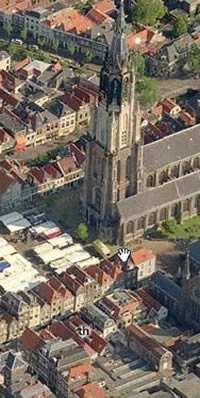
MICROSOFT'S Search Maps